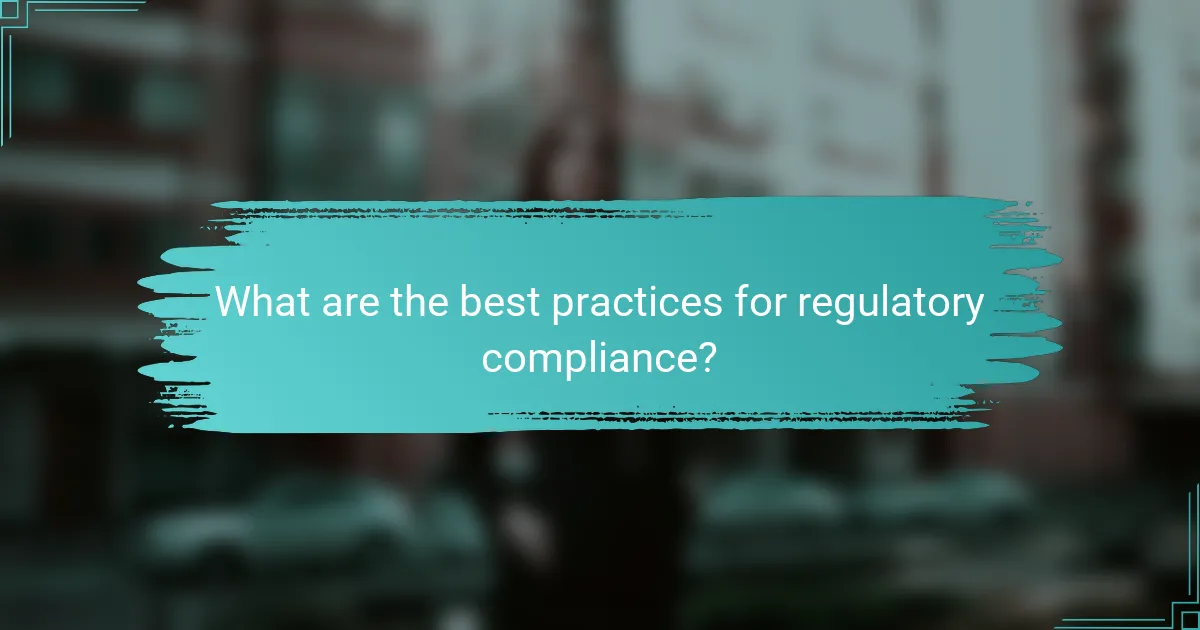Regulatory compliance is essential for organizations to navigate the complexities of legal requirements while minimizing risks. By establishing a clear framework, engaging with regulatory bodies, and conducting regular training and audits, businesses can effectively implement best practices. Understanding applicable laws and consulting with legal experts further enhances compliance strategies, fostering a culture of accountability and safeguarding against potential repercussions.

What are the best practices for regulatory compliance?
Best practices for regulatory compliance involve establishing a clear framework, ensuring regular training, maintaining thorough documentation, engaging with regulatory bodies, and conducting internal audits. These practices help organizations meet legal requirements while minimizing risks associated with non-compliance.
Establishing a compliance framework
A compliance framework serves as the foundation for regulatory adherence. It should outline policies, procedures, and responsibilities to ensure all employees understand their roles in compliance efforts. Consider using established models like ISO standards or industry-specific guidelines as a basis for your framework.
To create an effective framework, involve key stakeholders from various departments to ensure comprehensive coverage of all regulatory requirements. Regularly review and update the framework to adapt to changing regulations and organizational needs.
Regular training and updates
Regular training is crucial for keeping employees informed about compliance requirements and updates. Schedule training sessions at least annually, or more frequently if significant regulatory changes occur. Use a mix of in-person workshops and online courses to accommodate different learning styles.
Incorporate real-world scenarios and case studies into training to enhance understanding. Encourage feedback from employees to identify areas where additional training may be needed, ensuring that everyone remains compliant and aware of their responsibilities.
Documentation and record-keeping
Thorough documentation and record-keeping are essential for demonstrating compliance. Maintain accurate records of policies, training sessions, audits, and communications with regulatory bodies. This documentation can serve as evidence in case of audits or investigations.
Establish a centralized system for storing documents that is easily accessible to authorized personnel. Regularly review and update records to ensure they reflect current practices and regulations, and consider using digital tools to streamline this process.
Engaging with regulatory bodies
Proactively engaging with regulatory bodies can help organizations stay informed about compliance requirements and best practices. Attend industry conferences, participate in workshops, and subscribe to newsletters from relevant regulatory agencies to keep up with changes.
Establishing a good relationship with regulators can also facilitate smoother communication during audits or inspections. Be transparent and responsive to inquiries, demonstrating your commitment to compliance and cooperation.
Conducting internal audits
Regular internal audits are vital for assessing compliance with regulations and identifying areas for improvement. Schedule audits at least annually, or more frequently based on the complexity of your operations and regulatory environment. Use a checklist to ensure all relevant areas are covered during the audit process.
After conducting an audit, analyze the findings and develop an action plan to address any compliance gaps. Share the results with key stakeholders and use them as a basis for continuous improvement in your compliance efforts.

How can businesses ensure compliance with local regulations?
Businesses can ensure compliance with local regulations by thoroughly understanding applicable laws, consulting with legal experts, and implementing tailored compliance strategies. This proactive approach minimizes risks and fosters a culture of accountability.
Understanding local laws and regulations
To effectively comply with local regulations, businesses must first identify the specific laws relevant to their industry and location. This includes zoning laws, labor regulations, environmental standards, and data protection laws. Regularly reviewing these regulations is essential, as they can change frequently.
Utilizing resources such as government websites, industry associations, and legal databases can help in gathering accurate information. Keeping abreast of updates ensures that businesses remain compliant and avoid potential fines or legal issues.
Consulting with legal experts
Engaging with legal experts is crucial for navigating complex regulatory landscapes. Lawyers specializing in corporate law or compliance can provide tailored advice based on a business’s unique circumstances. This guidance can help identify potential compliance gaps and recommend necessary adjustments.
Consider establishing a relationship with a local attorney who understands the nuances of regional laws. This can be particularly beneficial for businesses operating in multiple jurisdictions, as regulations may vary significantly across regions.
Implementing localized compliance strategies
Localized compliance strategies should be developed to address the specific regulatory requirements of the area in which a business operates. This may involve creating internal policies, conducting employee training, and establishing monitoring systems to ensure adherence to regulations.
For example, a company in the European Union must comply with the General Data Protection Regulation (GDPR), which requires specific data handling practices. Implementing a clear data privacy policy and training staff on compliance can mitigate risks associated with non-compliance.
Regular audits and assessments of compliance strategies are also recommended to identify areas for improvement and ensure ongoing adherence to local regulations.

What are the consequences of non-compliance?
Non-compliance can lead to severe repercussions for businesses, including legal penalties, reputational harm, and operational disruptions. Understanding these consequences is crucial for maintaining compliance and safeguarding your organization.
Legal penalties and fines
Organizations that fail to comply with regulations may face significant legal penalties and fines. These can range from hundreds to millions of dollars, depending on the severity of the violation and the regulatory framework involved.
For example, financial institutions that violate anti-money laundering laws can incur fines that reach into the tens of millions. Regular audits and compliance checks can help mitigate these risks and ensure adherence to applicable laws.
Reputation damage
Non-compliance can severely damage a company’s reputation, leading to loss of customer trust and loyalty. Once a business is publicly associated with regulatory failures, it may struggle to regain its standing in the market.
Negative media coverage and customer backlash can have long-lasting effects, often resulting in decreased sales and diminished brand value. Companies should proactively communicate their compliance efforts to maintain a positive public image.
Operational disruptions
Failure to comply with regulations can lead to operational disruptions, including halted business activities and increased scrutiny from regulatory bodies. This can affect productivity and profitability, as resources may need to be redirected to address compliance issues.
For instance, a manufacturing company found in violation of safety standards may be forced to cease operations until compliance is achieved. Implementing robust compliance programs can help prevent such interruptions and ensure smooth business operations.

What frameworks can assist in compliance management?
Several frameworks can effectively support compliance management by providing structured approaches to meet regulatory requirements. Utilizing these frameworks helps organizations streamline processes, enhance accountability, and ensure adherence to relevant laws and standards.
ISO 19600 Compliance Management
ISO 19600 offers guidelines for establishing, developing, implementing, and improving an effective compliance management system. This framework emphasizes a risk-based approach, allowing organizations to identify and manage compliance risks efficiently.
Key steps include conducting regular compliance assessments, defining roles and responsibilities, and fostering a culture of compliance throughout the organization. For example, a company might implement training programs to ensure employees understand compliance obligations relevant to their roles.
COBIT Framework for IT Governance
COBIT provides a comprehensive framework for managing and governing enterprise IT, aligning IT goals with business objectives. It emphasizes the importance of compliance in IT governance, ensuring that technology-related processes meet regulatory requirements.
Organizations can leverage COBIT by establishing clear governance structures, defining performance metrics, and implementing controls to mitigate risks. For instance, a firm might use COBIT to ensure that data privacy regulations are adhered to by regularly auditing IT systems and processes.

How to choose the right compliance software?
Choosing the right compliance software involves evaluating your organization’s specific needs and the software’s capabilities. Focus on features that align with regulatory requirements and ensure the vendor has a solid reputation in the industry.
Assessing features and functionalities
When assessing features, prioritize functionalities that directly support your compliance objectives. Look for software that offers robust reporting tools, automated alerts for regulatory changes, and user-friendly interfaces. For example, software that integrates with existing systems can streamline processes and reduce manual errors.
Consider the scalability of the software as well. If your organization is growing, ensure the solution can adapt to increased demands without significant additional costs. A good practice is to create a checklist of must-have features and compare multiple options against this list.
Evaluating vendor reputation
Vendor reputation is crucial when selecting compliance software. Research the vendor’s history, customer reviews, and case studies to gauge their reliability and support services. A vendor with a long-standing presence in the market is often a safer choice.
Additionally, consider reaching out to current users for firsthand insights. Ask about their experiences with the software, including ease of use, customer support, and any challenges they faced. This feedback can provide valuable context that may not be evident from marketing materials alone.
